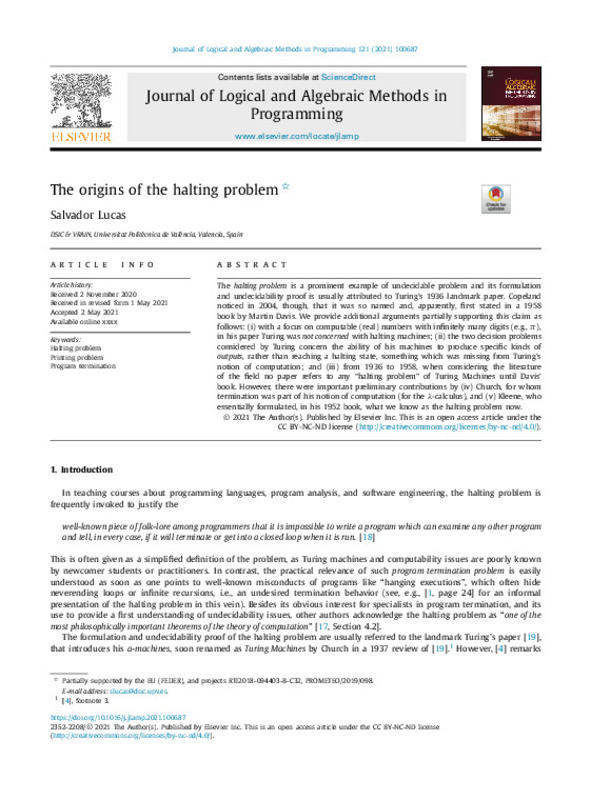JavaScript is disabled for your browser. Some features of this site may not work without it.
Buscar en RiuNet
Listar
Mi cuenta
Estadísticas
Ayuda RiuNet
Admin. UPV
The origins of the halting problem
Mostrar el registro sencillo del ítem
Ficheros en el ítem
| dc.contributor.author | Lucas Alba, Salvador
|
es_ES |
| dc.date.accessioned | 2022-11-08T12:21:40Z | |
| dc.date.available | 2022-11-08T12:21:40Z | |
| dc.date.issued | 2021-06 | es_ES |
| dc.identifier.issn | 2352-2208 | es_ES |
| dc.identifier.uri | http://hdl.handle.net/10251/189460 | |
| dc.description.abstract | [EN] The halting problem is a prominent example of undecidable problem and its formulation and undecidability proof is usually attributed to Turing's 1936 landmark paper. Copeland noticed in 2004, though, that it was so named and, apparently, first stated in a 1958 book by Martin Davis. We provide additional arguments partially supporting this claim as follows: (i) with a focus on computable (real) numbers with infinitely many digits (e.g., pi), in his paper Turing was not concerned with halting machines; (ii) the two decision problems considered by Turing concern the ability of his machines to produce specific kinds of outputs, rather than reaching a halting state, something which was missing from Turing's notion of computation; and (iii) from 1936 to 1958, when considering the literature of the field no paper refers to any "halting problem" of Turing Machines until Davis' book. However, there were important preliminary contributions by (iv) Church, for whom termination was part of his notion of computation (for the lambda-calculus), and (v) Kleene, who essentially formulated, in his 1952 book, what we know as the halting problem now. | es_ES |
| dc.description.sponsorship | Partially supported by the EU (FEDER), and projects RTI2018-094403-B-C32, PROMETEO/2019/098. | es_ES |
| dc.language | Inglés | es_ES |
| dc.publisher | Elsevier | es_ES |
| dc.relation.ispartof | Journal of Logical and Algebraic Methods in Programming | es_ES |
| dc.rights | Reconocimiento - No comercial - Sin obra derivada (by-nc-nd) | es_ES |
| dc.subject | Halting problem | es_ES |
| dc.subject | Printing problem | es_ES |
| dc.subject | Program termination | es_ES |
| dc.subject.classification | LENGUAJES Y SISTEMAS INFORMATICOS | es_ES |
| dc.title | The origins of the halting problem | es_ES |
| dc.type | Artículo | es_ES |
| dc.identifier.doi | 10.1016/j.jlamp.2021.100687 | es_ES |
| dc.relation.projectID | info:eu-repo/grantAgreement/AEI//RTI2018-094403-B-C32-AR//RAZONAMIENTO FORMAL PARA TECNOLOGIAS FACILITADORAS Y EMERGENTES/ | es_ES |
| dc.relation.projectID | info:eu-repo/grantAgreement/GENERALITAT VALENCIANA//PROMETEO%2F2019%2F098//DEEPTRUST/ | es_ES |
| dc.rights.accessRights | Abierto | es_ES |
| dc.contributor.affiliation | Universitat Politècnica de València. Escola Tècnica Superior d'Enginyeria Informàtica | es_ES |
| dc.description.bibliographicCitation | Lucas Alba, S. (2021). The origins of the halting problem. Journal of Logical and Algebraic Methods in Programming. 121:1-9. https://doi.org/10.1016/j.jlamp.2021.100687 | es_ES |
| dc.description.accrualMethod | S | es_ES |
| dc.relation.publisherversion | https://doi.org/10.1016/j.jlamp.2021.100687 | es_ES |
| dc.description.upvformatpinicio | 1 | es_ES |
| dc.description.upvformatpfin | 9 | es_ES |
| dc.type.version | info:eu-repo/semantics/publishedVersion | es_ES |
| dc.description.volume | 121 | es_ES |
| dc.relation.pasarela | S\444862 | es_ES |
| dc.contributor.funder | GENERALITAT VALENCIANA | es_ES |
| dc.contributor.funder | AGENCIA ESTATAL DE INVESTIGACION | es_ES |
| dc.contributor.funder | European Regional Development Fund | es_ES |








